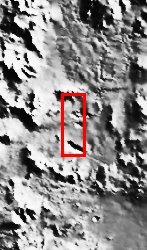- Original Caption Released with Image:
-

(Released 27 May 2002)
The Science
The transition zone between maze-like troughs of Noctis Labyrinthus and the main Valles Marineris canyon system are shown in this THEMIS visible camera image. This huge system of troughs near the equator of Mars was most likely created by tectonic forces which pulled apart the crust. In the top third of the image, on the western side of the northernmost trough, a buildup of relatively bright material on the plateau has led to an overflow into the trough. Most of the bottom of this trough is covered by sediment deposited from the plateau above. On the right-hand side of this same trough, on the southern wall, there is a thin streak of darker material that also seems to originate from the plateau above. This is most likely a gully formation. This feature could also be a dust avalanche, but because no other similar features are seen, this is unlikely. Other dark material deposited by some unknown process can also be seen all around the easternmost ridge in the trough. Near the bottom of the canyon, layers from the center ridges and the canyon wall can be matched, indicating that the ridges are made of the same material as the wall.
Near the bottom of the image, there is yet another depression. This trough is filled with sediment deposited from erosion of the trough wall and possibly from the plateau above. All around the walls of this trough a layer of rocky material can be also be seen. It appears that the areas directly below the rocky ledges are "shielded" from landslide material from above. Finally, in the northwestern wall of this trough, there is an irregular pattern of very bright material not seen anywhere else in the image. Identifying similar formations in other THEMIS visible camera images could provide some context for its occurrence and help us understand how it was formed.
The Story
Tectonic forces wrenched apart the crust on Mars long ago, forming deep troughs at the Martian equator like the ones seen here. They occur in a transition zone between the maze-like region of Noctis Labyrinthus and the deep canyon system of Valles Marineris, the largest and "grandest" canyon in the solar system. These cracks in the crust can give geologists a good idea of what has happened over the course of the planet's history.
Find out a little yourself by taking a closer look at the western side of the trough in the top third of the image. Can you see how the bright sediment from the plateau above has been whisked over the side, overflowing and building up on the floor below? Follow the south wall of this same trough, and you'll come across a dark streak running down (toward the right side of the image). One possibility is that it could be a dust avalanche, but if that were so, you'd think it would have occurred much more often, in more places than just that one spot. Since it didn't, scientists believe it probably isn't a dust avalanche, but could be a gully instead.
There's also some more dark material deposited all around the easternmost ridge in the trough as well. No one is quite sure how it formed there or exactly what it's made of. At the least, what geologists can tell is that the ridges in the trough are made of the same material as the canyon walls, since the layers in each of them match. Finding similarities like these can help piece together the story of Martian geology here.
When scientists study THEMIS images, however, they are also on the lookout for anything that looks unusual. Try studying the dark depression that carves out the bottom of this image. It too is filled soft-looking sediments, probably deposited from erosion of the trough wall and possibly from the plateau above. Rocky outcrops all around the walls of this trough shield the areas directly below them from landslides from above.
But all that seems pretty regular. Do you see anything that stands out? How about the odd pattern of brighter material that seems almost pasted on the northwestern wall of the trough like dried up glue? This material isn't found elsewhere in this image. Sights like this pose a geological mystery, and one of the only ways to solve it is to seek more clues. Do similar formations occur elsewhere on Mars? Stay tuned with THEMIS researchers, because they'll be looking, trying to understand how and how often such features form.
- Image Credit:
-
NASA/JPL/Arizona State University
Image Addition Date: -
2002-06-17
|

